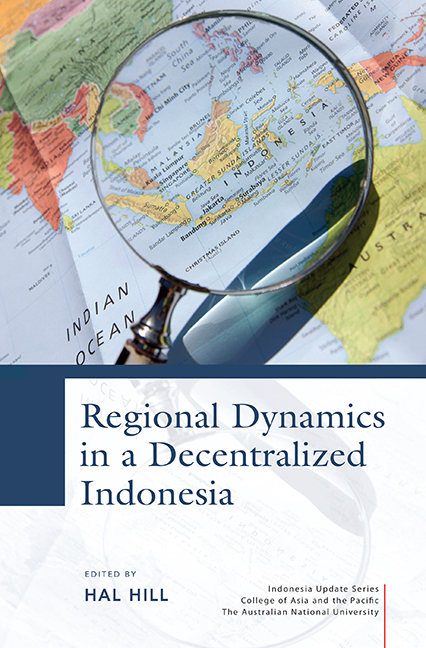Book contents
- Frontmatter
- Dedication
- Contents
- Tables
- Figures
- Contributors
- Acknowledgments
- Glossary
- Map of Indonesia
- 1 An introduction to the issues
- PART 1 HISTORICAL, ECONOMIC, POLITICAL AND SOCIAL PATTERNS
- 2 Before the ‘big bang’: decentralization debates and practice in Indonesia, 1949–99
- 3 Indonesia's decentralization: the rise of local identities and the survival of the nation-state
- 4 Hares and tortoises: regional development dynamics in Indonesia
- 5 Patterns of regional poverty in the new Indonesia
- PART 2 DECENTRALIZATION AND GOVERNANCE
- PART 3 LOCAL-LEVEL PERSPECTIVES
- PART 4 MIGRATION, CITIES AND CONNECTIVITY
- PART 5 CHALLENGES FOR INDONESIA'S PERIPHERY
- Author index
- Subject index
- INDONESIA UPDATE SERIES
2 - Before the ‘big bang’: decentralization debates and practice in Indonesia, 1949–99
from PART 1 - HISTORICAL, ECONOMIC, POLITICAL AND SOCIAL PATTERNS
Published online by Cambridge University Press: 21 October 2015
- Frontmatter
- Dedication
- Contents
- Tables
- Figures
- Contributors
- Acknowledgments
- Glossary
- Map of Indonesia
- 1 An introduction to the issues
- PART 1 HISTORICAL, ECONOMIC, POLITICAL AND SOCIAL PATTERNS
- 2 Before the ‘big bang’: decentralization debates and practice in Indonesia, 1949–99
- 3 Indonesia's decentralization: the rise of local identities and the survival of the nation-state
- 4 Hares and tortoises: regional development dynamics in Indonesia
- 5 Patterns of regional poverty in the new Indonesia
- PART 2 DECENTRALIZATION AND GOVERNANCE
- PART 3 LOCAL-LEVEL PERSPECTIVES
- PART 4 MIGRATION, CITIES AND CONNECTIVITY
- PART 5 CHALLENGES FOR INDONESIA'S PERIPHERY
- Author index
- Subject index
- INDONESIA UPDATE SERIES
Summary
INTRODUCTION
Indonesia's ‘big bang’ decentralization program has already generated a considerable literature, although few of the published studies examine the post-2001 changes in light of previous debates on central–regional political and economic relations in Indonesia. A common assumption appears to be that the system in place from the transfer of power from the Dutch in 1949 until the end of the Suharto era in 1998 was highly centralized. Section 2.2 of this chapter reviews the changes in the structure and role of provincial and subprovincial governments in Indonesia after independence, and examines the debates in the early 1950s culminating in the Nasroen proposals for reforming central–regional fiscal relations. Had the proposals been properly implemented, they would have made a considerable difference to the future course of central–regional relations. But they turned out to be the road not followed; instead, after Suharto took power in 1966, a process of recentralization of economic and political power took place. Section 2.3 examines the consequences of the Suharto-era policies for regional development in Java and elsewhere.
DEVELOPMENT OF REGIONAL GOVERNMENT AFTER 1950
Federalism: the path not taken
To many observers both at the time and later, it would have seemed logical for the newly independent Indonesian republic to choose a federal constitutional structure in 1949. Indeed, as Feith (1962: 72) has claimed, there were some convinced advocates of a federal structure within the republican leadership, ‘and Prime Minister Hatta appeared at times to be one of them’. In an interview after Suharto had left office, Feith pointed out that Hatta, ‘who played the central role in dissolving that federal structure, was actually a federalist’ (Jakarta Post, 18 November 1999). Hatta became Indonesia's first prime minister after the Dutch finally conceded sovereignty in 1949. He wanted to hold an election immediately so that an elected body could decide between a federal and a unitary state. But this did not happen; instead, general elections were held only in September 1955. Elections for a Constituent Assembly (Konstituante), which was to decide on a constitution, followed in December 1955. Voter turnout for both elections was high (Nasution 1992: 30).
- Type
- Chapter
- Information
- Regional Dynamics in a Decentralized Indonesia , pp. 25 - 44Publisher: ISEAS–Yusof Ishak InstitutePrint publication year: 2014



